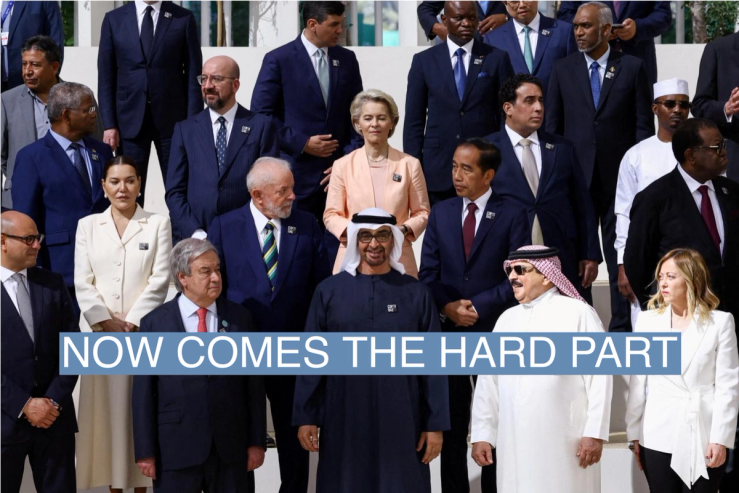The News
COP28 opened with a bang: Within hours of starting, summit President Sultan al-Jaber gaveled in a new fund to provide climate reparations payments — “loss and damage” — to low-income countries impacted by disasters. At the beginning of last year’s COP, the creation of such a fund wasn’t even on the agenda. Now it officially exists, with about $500 million dedicated from the U.S., the UAE, European countries, and Japan.
Now comes the hard part: Making it work.
“It’s not clear how another small fund will meaningfully address these problems,” said Clemence Landers, a senior policy fellow at the Center for Global Development who previously worked on development finance in the U.S. Department of the Treasury and the World Bank.
In this article:
Tim’s view
The loss and damage fund, which will be overseen by the World Bank, is a major test for the bank’s President Ajay Banga, who will need to prove that it can be handled more effectively than other climate funds under the bank’s supervision. And COP28 delegates have a lot more work to do on solving other problems in climate finance which are essential to take pressure off the loss and damage fund by limiting damage in the first place.
The new fund will follow a similar model to the Green Climate Fund and Global Environment Facility, two other funds that support climate-related projects in developing countries. Those funds, which have independent boards but for which the World Bank is the trustee, are notoriously slow-moving and difficult for countries to access. Although the GCF is equipped with more than $20 billion, it ekes out barely $3 billion per year in financing, partly because the application process is so cumbersome that many low-income countries don’t have the resources to navigate it, and partly because the fund’s managers share the same aversion to the perceived risks of investing in developing countries that are common among private lenders.
“These funds are operating as less than the sum of their parts,” Landers said. “There’s not much correlation between where the funding is going and who needs it most.”
Whether the loss and damage fund can function more effectively will depend on its board, the members of which haven’t yet been appointed. It’s also not yet clear how much the World Bank itself will be involved in financing decisions, or how much it will charge for its trusteeship — an early proposal was up to 30%, said Alex Scott, geopolitics lead at the think tank E3G.
Then there’s the question of getting more money into it. The initial round of pledges came from the usual cast of climate-finance donors, and there’s simply no way for that small group to raise enough on its own. China, Saudi Arabia, and many other large emitters remain absent. In a speech at COP28 Friday afternoon, Mia Mottley, prime minister of Barbados, said that the best way to raise funds at scale is to draw in consumers and companies, through surcharges on airline tickets and new taxes on oil and gas production and international shipping.
“The scale of [the fund’s] capitalization is of concern to all,” Mottley said. “At the end of the day, we need to have a mechanism that can secure international taxation.”
Room for Disagreement
Avinash Persaud, Mottley’s top finance advisor, told Semafor he’s not overly worried about how well the fund will function, and that hosting it at the World Bank is “better than the alternative” of not getting the fund at all. The more important goal for COP28, he said, is to lock in other items on Mottley’s laundry list of proposed international finance reforms, like pausing sovereign debt repayments after disasters. Negotiators will haggle over the next week on whether any of these ideas will be enshrined in the COP’s final official outcome. One of them — a new agency to guarantee foreign exchange rates for clean-energy projects in developing countries that would make developers more comfortable dealing in relatively volatile currencies — is unlikely to get sufficient support, Persaud said.
The View From India
The biggest challenge in climate finance is getting more private sector investment in clean energy and adaptation projects in developing countries. To that end, the UAE on Friday afternoon announced a new fund that aims to take some of the early risk out of those investments. The $30 billion fund is comprised of co-investment from the UAE, BlackRock, and the private equity firms TPG and Brookfield. Of that, $5 billion is meant to target developing countries, starting with clean energy projects in India (the other $25 billion will target more traditional clean energy investments in richer countries). The idea is that if the fund takes on some first-mover risk, other investors will follow suit. A report by BlackRock this week projected that if development banks are able to similarly step up their concessional first-mover lending in developing countries, the private sector could follow suit with an additional $200 billion per year by 2030.
“We’re seeing really exciting opportunities,” David Giordano, BlackRock’s global head of climate infrastructure, told a group of reporters on the COP sidelines. “With the right blend of finance, there’s a lot of demand from our clients to participate in markets where they wouldn’t normally get exposure.”


